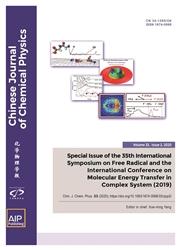改变原子电负性对苯并恶唑异硫氰酸酯荧光染料激发态质子转移过程和光物理性质的调控
IF 1.2
4区 化学
Q4 PHYSICS, ATOMIC, MOLECULAR & CHEMICAL
引用次数: 0
摘要
激发态分子内质子转移(ESIPT)因其独特的光学性质而受到研究人员的青睐。然而,关于改变原子电负性对ESIPT过程和光物理性质的影响的系统研究相对较少。因此,我们通过理论方法选择了一系列苯并恶唑异硫氰酸酯荧光染料(2-HOB、2-HSB和2-HSeB),并通过改变硫族原子的电负性,系统地研究了ESIPT过程和光物理性质。计算的键角、键长、能隙和红外光谱分析表明,三种分子的分子内氢键强度的顺序为2-HOB2-HSB>2-HSeB。此外,计算的电子光谱表明,随着原子电负性的降低,发射光谱发生红移。因此,本工作将为基于ESIPT性能的新型染料的合成和应用提供一定的理论指导。本文章由计算机程序翻译,如有差异,请以英文原文为准。
Regulation of excited-state intramolecular proton transfer process and photophysical properties for benzoxazole isothiocyanate fluorescent dyes by changing atomic electronegativity
Excited-state intramolecular proton transfer (ESIPT) is favored by researchers because of its unique optical properties. However, there are relatively few systematic studies on the effects of changing the electronegativity of atoms on the ESIPT process and photophysical properties. Therefore, we selected a series of benzoxazole isothiocyanate fluorescent dyes (2-HOB, 2-HSB, and 2-HSeB) by theoretical methods, and systematically studied the ESIPT process and photophysical properties by changing the electronegativity of chalcogen atoms. The calculated bond angle, bond length, energy gap, and infrared spectrum analysis show that the order of the strength of intramolecular hydrogen bonding of the three molecules is 2-HOB<2-HSB<2-HSeB. Correspondingly, the magnitude of the energy barrier of the potential energy curve is 2-HOB>2-HSB>2-HSeB. In addition, the calculated electronic spectrum shows that as the atomic electronegativity decreases, the emission spectrum has a redshift. Therefore, this work will offer certain theoretical guidance for the synthesis and application of new dyes based on ESIPT properties.
求助全文
通过发布文献求助,成功后即可免费获取论文全文。
去求助
来源期刊

Chinese Journal of Chemical Physics
物理-物理:原子、分子和化学物理
CiteScore
1.90
自引率
10.00%
发文量
2763
审稿时长
3 months
期刊介绍:
Chinese Journal of Chemical Physics (CJCP) aims to bridge atomic and molecular level research in broad scope for disciplines in chemistry, physics, material science and life sciences, including the following:
Theoretical Methods, Algorithms, Statistical and Quantum Chemistry
Gas Phase Dynamics and Structure: Spectroscopy, Molecular Interactions, Scattering, Photochemistry
Condensed Phase Dynamics, Structure, and Thermodynamics: Spectroscopy, Reactions, and Relaxation Processes
Surfaces, Interfaces, Single Molecules, Materials and Nanosciences
Polymers, Biopolymers, and Complex Systems
Other related topics
 求助内容:
求助内容: 应助结果提醒方式:
应助结果提醒方式:


